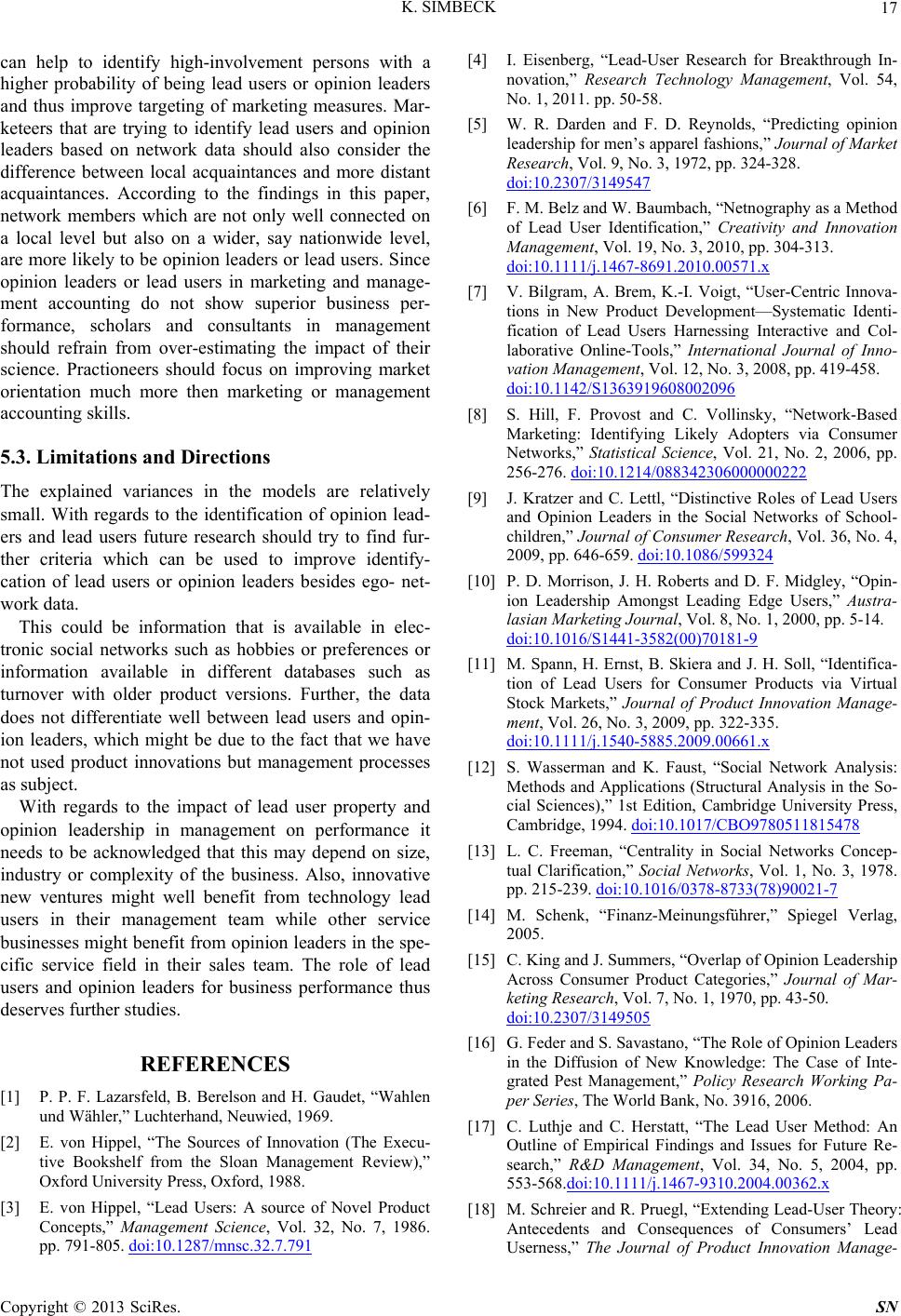
K. SIMBECK 17
can help to identify high-involvement persons with a
higher probability of being lead users or opinion leaders
and thus improve targeting of marketing measures. Mar-
keteers that are trying to identify lead users and opinion
leaders based on network data should also consider the
difference between local acquaintances and more distant
acquaintances. According to the findings in this paper,
network members which are not only well connected on
a local level but also on a wider, say nationwide level,
are more likely to be opinion leaders or lead users. Since
opinion leaders or lead users in marketing and manage-
ment accounting do not show superior business per-
formance, scholars and consultants in management
should refrain from over-estimating the impact of their
science. Practioneers should focus on improving market
orientation much more then marketing or management
accounting skills.
5.3. Limitations and Directions
The explained variances in the models are relatively
small. With regards to the identification of opinion lead-
ers and lead users future research should try to find fur-
ther criteria which can be used to improve identify-
cation of lead users or opinion leaders besides ego- net-
work data.
This could be information that is available in elec-
tronic social networks such as hobbies or preferences or
information available in different databases such as
turnover with older product versions. Further, the data
does not differentiate well between lead users and opin-
ion leaders, which might be due to the fact that we have
not used product innovations but management processes
as subject.
With regards to the impact of lead user property and
opinion leadership in management on performance it
needs to be acknowledged that this may depend on size,
industry or complexity of the business. Also, innovative
new ventures might well benefit from technology lead
users in their management team while other service
businesses might benefit from opinion leaders in the spe-
cific service field in their sales team. The role of lead
users and opinion leaders for business performance thus
deserves further studies.
REFERENCES
[1] P. P. F. Lazarsfeld, B. Berelson and H. Gaudet, “Wahlen
und Wähler,” Luchterhand, Neuwied, 1969.
[2] E. von Hippel, “The Sources of Innovation (The Execu-
tive Bookshelf from the Sloan Management Review),”
Oxford University Press, Oxford, 1988.
[3] E. von Hippel, “Lead Users: A source of Novel Product
Concepts,” Management Science, Vol. 32, No. 7, 1986.
pp. 791-805. doi:10.1287/mnsc.32.7.791
[4] I. Eisenberg, “Lead-User Research for Breakthrough In-
novation,” Research Technology Management, Vol. 54,
No. 1, 2011. pp. 50-58.
[5] W. R. Darden and F. D. Reynolds, “Predicting opinion
leadership for men’s apparel fashions,” Journal of Market
Research, Vol. 9, No. 3, 1972, pp. 324-328.
doi:10.2307/3149547
[6] F. M. Belz and W. Baumbach, “Netnography as a Method
of Lead User Identification,” Creativity and Innovation
Management, Vol. 19, No. 3, 2010, pp. 304-313.
doi:10.1111/j.1467-8691.2010.00571.x
[7] V. Bilgram, A. Brem, K.-I. Voigt, “User-Centric Innova-
tions in New Product Development—Systematic Identi-
fication of Lead Users Harnessing Interactive and Col-
laborative Online-Tools,” International Journal of Inno-
vation Management, Vol. 12, No. 3, 2008, pp. 419-458.
doi:10.1142/S1363919608002096
[8] S. Hill, F. Provost and C. Vollinsky, “Network-Based
Marketing: Identifying Likely Adopters via Consumer
Networks,” Statistical Science, Vol. 21, No. 2, 2006, pp.
256-276. doi:10.1214/088342306000000222
[9] J. Kratzer and C. Lettl, “Distinctive Roles of Lead Users
and Opinion Leaders in the Social Networks of School-
children,” Journal of Consumer Research, Vol. 36, No. 4,
2009, pp. 646-659. doi:10.1086/599324
[10] P. D. Morrison, J. H. Roberts and D. F. Midgley, “Opin-
ion Leadership Amongst Leading Edge Users,” Austra-
lasian Marketing Journal, Vol. 8, No. 1, 2000, pp. 5-14.
doi:10.1016/S1441-3582(00)70181-9
[11] M. Spann, H. Ernst, B. Skiera and J. H. Soll, “Identifica-
tion of Lead Users for Consumer Products via Virtual
Stock Markets,” Journal of Product Innovation Manage-
ment, Vol. 26, No. 3, 2009, pp. 322-335.
doi:10.1111/j.1540-5885.2009.00661.x
[12] S. Wasserman and K. Faust, “Social Network Analysis:
Methods and Applications (Structural Analysis in the So-
cial Sciences),” 1st Edition, Cambridge University Press,
Cambridge, 1994. doi:10.1017/CBO9780511815478
[13] L. C. Freeman, “Centrality in Social Networks Concep-
tual Clarification,” Social Networks, Vol. 1, No. 3, 1978.
pp. 215-239. doi:10.1016/0378-8733(78)90021-7
[14] M. Schenk, “Finanz-Meinungsführer,” Spiegel Verlag,
2005.
[15] C. King and J. Summers, “Overlap of Opinion Leadership
Across Consumer Product Categories,” Journal of Mar-
keting Research, Vol. 7, No. 1, 1970, pp. 43-50.
doi:10.2307/3149505
[16] G. Feder and S. Savastano, “The Role of Opinion Leaders
in the Diffusion of New Knowledge: The Case of Inte-
grated Pest Management,” Policy Research Working Pa-
per Series, The World Bank, No. 3916, 2006.
[17] C. Luthje and C. Herstatt, “The Lead User Method: An
Outline of Empirical Findings and Issues for Future Re-
search,” R&D Management, Vol. 34, No. 5, 2004, pp.
553-568.doi:10.1111/j.1467-9310.2004.00362.x
[18] M. Schreier and R. Pruegl, “Extending Lead-User Theory:
Antecedents and Consequences of Consumers’ Lead
Userness,” The Journal of Product Innovation Manage-
Copyright © 2013 SciRes. SN